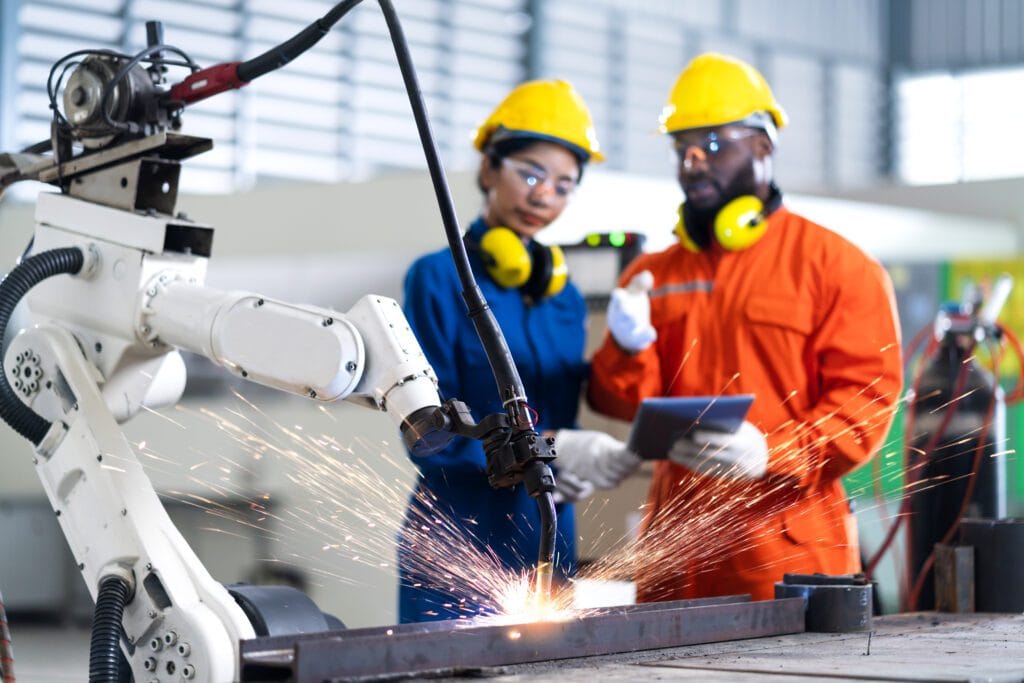
Introduction: Why Robotics Fascinates Everyone
- Introduction: Why Robotics Fascinates Everyone
- Real-Life Examples of Robots You Already See
- The Connection Between AI and Robotics
- Components of a Robot (Simplified for Beginners)
- Types of Robots
- DIY Guide: Build Your First Simple Robot
- Future of Robotics: What to Expect in 2025 and Beyond
- Common Misconceptions About Robotics
- How to Start Learning Robotics (Step-by-Step)
- FAQs:
- Conclusion: Robotics is For Everyone
If Artificial Intelligence is the brain, then robotics is the body.
Think about it—AI makes machines “think,” but without robotics, those machines would just stay inside a computer screen. Robotics brings intelligence into the physical world. From vacuum robots cleaning your home to giant robotic arms building cars in factories, robots are everywhere—even if you don’t notice them.
In our previous article on Artificial Intelligence (internal linking opportunity), we explained how machines learn and make smart decisions. Now, let’s go one step further and explore: what happens when those smart decisions are combined with real-world actions? That’s robotics.
This beginner-friendly DIY guide will:
- Explain robotics in simple, human language.
- Show real-life examples of robots around you.
- Help you understand the parts of a robot.
- Share DIY steps for building your first robot.
- Clear common doubts with FAQs.
By the end, you’ll not only understand robotics but also feel inspired to create your own mini-robot at home.
What is Robotics?
Robotics is a branch of technology that deals with designing, building, and operating machines (robots) that can perform tasks automatically.
👉 Think of robotics as the art of building helpers.
- A washing machine is a simple robot—it follows a program to wash clothes.
- A drone is a flying robot—it can be controlled or even fly itself.
- A self-driving car is a robot with wheels.
So, Robotics = Making machines that sense, think, and act in the real world.
Real-Life Examples of Robots You Already See
You don’t need to go to a lab to find robots. Chances are, you’ve already interacted with them today:
- Vacuum Robots (Roomba): Cleans floors without your help.
- ATMs: A robot that gives you money on command.
- Chatbots with voice (like Alexa + smart home devices): Respond and act physically (turn lights on/off).
- Industrial Robots: Building cars, packing goods, welding.
- Medical Robots: Assisting doctors in surgeries.
👉 In short: Robots are not science fiction anymore—they’re daily life companions.
The Connection Between AI and Robotics
Remember the first article on AI? AI gives brains to machines. Robotics gives them a body.
- AI without Robotics = Smart chatbot on your screen.
- Robotics without AI = A toy car that moves forward when you press a button.
- AI + Robotics Together = A self-driving car that senses traffic, makes decisions, and moves safely.
This is why AI and Robotics are often taught together. One cannot reach its full potential without the other.
Components of a Robot (Simplified for Beginners)
A robot may look complex, but it’s just made of 4 main parts:
- Sensors (Eyes & Ears): Detect the environment.
- Example: Ultrasonic sensors detect obstacles, cameras “see” surroundings.
- Example: Ultrasonic sensors detect obstacles, cameras “see” surroundings.
- Brain (Controller): Processes information.
- Example: Arduino, Raspberry Pi, or even AI running on a laptop.
- Example: Arduino, Raspberry Pi, or even AI running on a laptop.
- Actuators (Hands & Legs): Help robots move and act.
- Example: Motors, wheels, robotic arms.
- Example: Motors, wheels, robotic arms.
- Power (Energy): Batteries or power supply.
👉 Analogy: A robot is like a human.
- Sensors = eyes/ears,
- Brain = mind,
- Actuators = hands/legs,
- Power = food/energy.
Types of Robots
Robots come in many shapes and sizes, but here’s a simple classification:
- Industrial Robots: Machines in factories (assembly, welding).
- Service Robots: Vacuum cleaners, delivery robots.
- Humanoid Robots: Robots that look and act like humans (Sophia robot).
- Autonomous Robots: Self-driving cars, drones.
- Educational Robots: LEGO Mindstorms, Arduino kits for students.
DIY Guide: Build Your First Simple Robot
Yes, you can build a robot at home—even if you’re a complete beginner. Here’s a step-by-step beginner project:
Project: Line-Following Robot (Beginner DIY)
What it does: A small car that follows a black line on the ground.
Components You Need:
- Arduino board (the brain)
- Motor driver (to control wheels)
- Two DC motors + wheels
- IR sensors (to detect the line)
- Battery pack
Steps:
- Assemble the chassis with motors and wheels.
- Connect motors to motor driver and Arduino.
- Attach IR sensors in front.
- Upload Arduino code (available free online).
- Place robot on a track with black tape.
👉 Result: Your robot will follow the path automatically. Congratulations—you just built your first robot!
Future of Robotics: What to Expect in 2025 and Beyond
- Healthcare: Robotic nurses and AI-assisted surgeries.
- Logistics: Robots sorting and delivering parcels (Amazon warehouses already use them).
- Education: Every school teaching robotics as a core subject.
- Home automation: Robots cooking, cleaning, and assisting the elderly.
👉 In the coming decade, robotics will move from labs into every home.
Common Misconceptions About Robotics
- “Robots will take over humans.”
❌ Reality: Robots are tools built by humans to assist, not replace us. - “Robotics is only for engineers.”
❌ Reality: With DIY kits, anyone—including school kids—can build robots today. - “Building robots is too expensive.”
❌ Reality: Starter kits are cheaper than smartphones.
How to Start Learning Robotics (Step-by-Step)
- Start with Arduino (easy coding + cheap).
- Try DIY robotics kits available online.
- Learn basics of coding (Python or C).
- Join free robotics communities on YouTube and forums.
- Build small projects → line-follower, obstacle-avoiding car, Bluetooth-controlled robot.
FAQs:
Q1. What is robotics in simple words?
Robotics is the science of building machines (robots) that can sense, think, and act like humans.
Q2. What are 5 real-life examples of robots?
Vacuum robots, ATMs, drones, industrial arms, and chatbots with voice control.
Q3. How do beginners start robotics?
Start with simple Arduino or Raspberry Pi kits and try DIY projects.
Q4. Is robotics hard to learn?
No. With today’s DIY kits, anyone can build simple robots at home.
Q5. Do robots need AI?
Not always. A toy robot works without AI, but advanced robots (like self-driving cars) use AI.
Q6. How much does it cost to build a basic robot?
A beginner robot kit costs around $30–50 (₹2,500–₹4,000 in India).
Q7. Can robotics be a career?
Yes. Robotics engineers, AI+Robotics developers, and automation experts are among the top careers in 2025.
Q8. What’s the difference between AI and Robotics?
AI is the “brain” (thinking), robotics is the “body” (acting). Together, they make intelligent machines.
Conclusion: Robotics is For Everyone
Robotics is not just about futuristic machines—it’s about building helpers that make human life easier. Whether it’s a vacuum cleaner at home, a robot in surgery, or a drone delivering packages, robotics is shaping the future.
The good news? You don’t have to wait for tomorrow to be part of this future. With simple DIY kits and beginner-friendly tutorials, you can start building robots today.
👉 My advice: Start small, dream big. Build your first robot, and you’ll realize that robotics isn’t rocket science—it’s the future you can hold in your hands.


